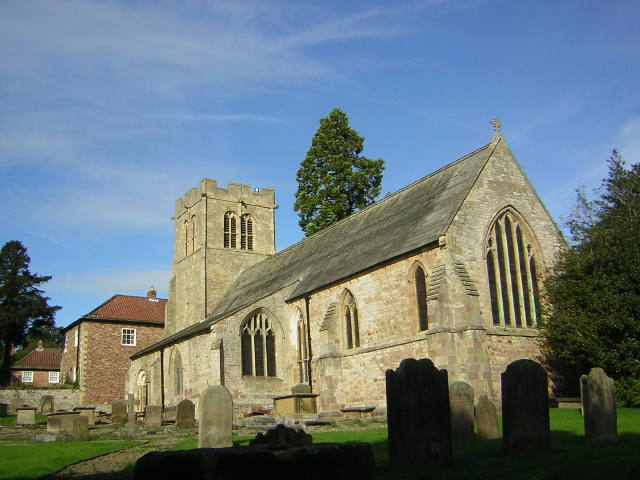Goldsborough, Harrogate on:
[Wikipedia]
[Google]
[Amazon]
Goldsborough is a village and civil parish in the Harrogate district of North Yorkshire, England. It is situated near the
 The Church of St Mary the Virgin is a Grade I listed medieval church. The oldest section of the building, the south Norman doorway, dates to the 12th century. Restoration work was carried out for the Byerley family in 1750, and in 1859 by
The Church of St Mary the Virgin is a Grade I listed medieval church. The oldest section of the building, the south Norman doorway, dates to the 12th century. Restoration work was carried out for the Byerley family in 1750, and in 1859 by
Goldsborough HallGoldsborough Village websiteGoldsborough's Hoard at the British Museum
{{authority control Villages in North Yorkshire Civil parishes in North Yorkshire Borough of Harrogate
River Nidd
The River Nidd is a tributary of the River Ouse in the English county of North Yorkshire. In its first few miles it is dammed three times to create Angram Reservoir, Scar House Reservoir and Gouthwaite Reservoir, which attract a total of aroun ...
and east of Knaresborough. Goldsborough is recognised by the well-known stately home Goldsborough Hall and its other features including: Goldsborough Primary School, the Bay Horse Inn and the Goldsborough Cricket Grounds.
The village was historically part of the West Riding of Yorkshire until 1974.
History
The village appears in the Domesday Book as Golburg or Goldeburgh, which means Golda's Burgh (with Burgh meaning a fortified place). It was in the possession of the de Goldesburgh, Hutton and Byerley families at that time. The village was the seat of the short-lived Wytham Baronetcy during the 1680s. A Viking hoard was discovered in Goldsborough Village in 1859 during construction outside the north wall of Goldsborough Church. Coins and artefacts dating from 700 to 1050 were found in a leaden chest including fragments of Viking brooches and arm rings, together with 39 coins. It forms one of the largest collections ever discovered in the UK and is now held at the British Museum in London. The village has a Church of England affiliated primary school which takes pupils from the surrounding settlements of Allerton, Coneythorpe, Hopperton and Flaxby. Goldsborough was used by Yorkshire Television in the filming of '' The New Statesman''. Goldsborough used to have a railway station on the Harrogate to York railway line. The station was located north-east of the village. The site is where the current A59 passes over the railway line. The village has one public house; The Bay Horse Inn which was built in the mid-late 18th century. Located at the junction of Church Street and Station Road, in front of the inn, the village war memorial commemorates victims of both world wars. it consists of an inscribed stone plinth surmounted by a cross. In the 2001 Census, the population of the parish was 493, which had dropped to 469 by the time of the 2011 Census. In 2015, North Yorkshire County Council estimated that the population had dropped again to 460.Landmarks
Goldsborough Hall
Goldsborough Hall is a Grade II* listed building that was built for Richard Hutton. It was bought by Daniel Lascelles in 1760. It became the home of Princess Mary from her marriage to Henry Lascelles in 1922 until he became Earl of Harewood.Church of St Mary
 The Church of St Mary the Virgin is a Grade I listed medieval church. The oldest section of the building, the south Norman doorway, dates to the 12th century. Restoration work was carried out for the Byerley family in 1750, and in 1859 by
The Church of St Mary the Virgin is a Grade I listed medieval church. The oldest section of the building, the south Norman doorway, dates to the 12th century. Restoration work was carried out for the Byerley family in 1750, and in 1859 by George Gilbert Scott
Sir George Gilbert Scott (13 July 1811 – 27 March 1878), known as Sir Gilbert Scott, was a prolific English Gothic Revival architect, chiefly associated with the design, building and renovation of churches and cathedrals, although he started ...
. In the church there are memorials to Richard de Goldsburgh (d.1308) and his son (d.1333), both are effigies of an armoured knight. There are also memorials to past residents of Goldsborough Hall; Robert Byerley and Daniel Lascelles.
The church was the setting for the baptism of George Henry Hubert Lascelles
George Henry Hubert Lascelles, 7th Earl of Harewood, (7 February 1923 – 11 July 2011), styled The Honourable George Lascelles before 1929 and Viscount Lascelles between 1929 and 1947, was a British classical music administrator and author. He ...
, first cousin of Queen Elisabeth II. The baptism was attended by his grandparents King George V and Queen Mary.
Within the churchyard there is a medieval cross base. This scheduled monument consists of a large cylindrical block of stone upon a square plinth. A small Viking enamelled strap end was found here .
References
External links
Goldsborough Hall
{{authority control Villages in North Yorkshire Civil parishes in North Yorkshire Borough of Harrogate